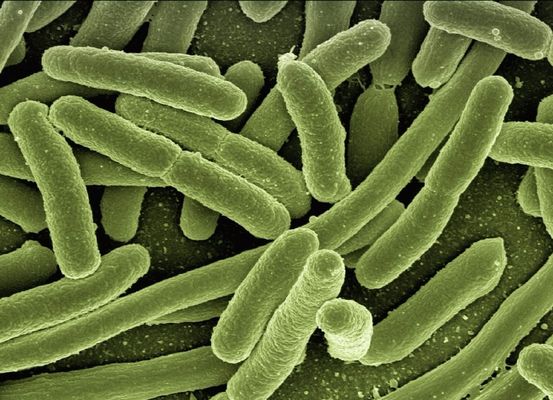10.1.1
Transmission of Disease
Disease Transmission
Disease Transmission
Diseases that can be passed between animal and plant individuals are known as transmissible or infectious. Transmission of these diseases is either direct or indirect.


Pathogens
Pathogens
- Communicable diseases are caused by harmful microorganisms, called pathogens.
- Examples of pathogenic microorganisms include:
- Bacteria.
- Viruses.
- Protoctista.
- Fungi.


Direct transmission
Direct transmission
- Physical contact is made between an infected animal or plant, spreading the pathogen between individuals.
- Direct transmission can take place via bodily fluids such as saliva, blood and semen.


Indirect transmission
Indirect transmission
- Pathogens are NOT spread through physical contact, but instead by:
- Animal vectors, such as mosquitoes and aphids.
- Air or waterborne transmission by cough droplets or fungal spores.
- Fomites, such as door handles, which are objects onto which pathogens are shed.
- Human movements, which transport infected material on footwear, vehicles and tools.


Non-infectious diseases
Non-infectious diseases
- Non-infectious diseases cannot be passed between individuals.
- They can include inherited diseases, such as sickle cell anaemia.
- They also include genetic diseases, like cancer.


Pathogens
Pathogens
- You need to know the following pathogens:
- Vibrio cholerae bacteria, which causes cholera.
- Plasmodium falciparum, Plasmodium vivax, Plasmodium ovale and Plasmodium malariae protozoa, which cause malaria.
- Mycobacterium tuberculosis & Mycobacterium bovis bacteria which both cause tuberculosis (TB).
- Human Immunodeficiency Virus (HIV), which causes acquired immunodeficiency syndrome (AIDS).
- Variola virus, which causes smallpox.
- Morbillivirus virus, which causes measles.
Risk Factors for Disease
Risk Factors for Disease
Not all people are at equal risk of getting communicable diseases. These are some of the factors that can increase an individual's disease risk:


Having a weaker immune system
Having a weaker immune system
- A weak immune system makes it much harder to fight off disease.
- People with weak immune systems include:
- Babies and young children.
- Elderly people.
- HIV infection sufferers.
- Those with chronic underlying conditions, like asthma and diabetes.


Living in crowded conditions
Living in crowded conditions
- People who live in close proximity to lots of other people are more likely to spread pathogens, especially in:
- Nursing and residential homes.
- Prisons.
- Hospitals.
- Homeless shelters.


Having poor access to healthcare
Having poor access to healthcare
- Limited access to healthcare or lack of engagement with health professionals can mean diseases are not treated early enough and their progression is more serious.
- Poor healthcare is a key issue in many developing countries.
1Cell Structure
1.1Cell Structure
1.1.1Studying Cells - Microscopes
1.1.2Introduction to Eukaryotic & Prokaryotic Cells
1.1.3Ultrastructure of Eukaryotic Cells
1.1.4Ultrastructure of Eukaryotic Cells 2
1.1.5Ultrastructure of Eukaryotic Cells 3
1.1.6Prokaryotic Cells
1.1.7Viruses
1.1.8End of Topic Test - Cell Structure
1.1.9Exam-Style Question - Microscopes
1.1.10A-A* (AO2/3) - Cell Structure
2Biological Molecules
2.1Testing for Biological Modules
2.2Carbohydrates & Lipids
2.3Proteins
3Enzymes
4Cell Membranes & Transport
4.1Biological Membranes
5The Mitotic Cell Cycle
6Nucleic Acids & Protein Synthesis
6.1Nucleic Acids
7Transport in Plants
8Transport in Mammals
8.1Circulatory System
8.2Transport of Oxygen & Carbon Dioxide
9Gas Exchange
9.1Gas Exchange System
10Infectious Diseases
10.1Infectious Diseases
10.2Antibiotics
11Immunity
12Energy & Respiration (A2 Only)
13Photosynthesis (A2 Only)
14Homeostasis (A2 Only)
14.1Homeostasis
14.2The Kidney
14.3Cell Signalling
14.4Blood Glucose Concentration
14.5Homeostasis in Plants
15Control & Coordination (A2 Only)
15.1Control & Coordination in Mammals
15.1.1Neurones
15.1.2Receptors
15.1.3Taste
15.1.4Reflexes
15.1.5Action Potentials
15.1.6Saltatory Conduction
15.1.7Synapses
15.1.8Cholinergic Synnapses
15.1.9Neuromuscular Junction
15.1.10Skeletal Muscle
15.1.11Sliding Filament Theory Contraction
15.1.12Sliding Filament Theory Contraction 2
15.1.13Menstruation
15.1.14Contraceptive Pill
15.2Control & Co-Ordination in Plants
16Inherited Change (A2 Only)
16.1Passage of Information to Offspring
16.2Genes & Phenotype
17Selection & Evolution (A2 Only)
17.2Natural & Artificial Selection
18Classification & Conservation (A2 Only)
18.1Biodiversity
18.2Classification
19Genetic Technology (A2 Only)
19.1Manipulating Genomes
19.2Genetic Technology Applied to Medicine
19.3Genetically Modified Organisms in Agriculture
Jump to other topics
1Cell Structure
1.1Cell Structure
1.1.1Studying Cells - Microscopes
1.1.2Introduction to Eukaryotic & Prokaryotic Cells
1.1.3Ultrastructure of Eukaryotic Cells
1.1.4Ultrastructure of Eukaryotic Cells 2
1.1.5Ultrastructure of Eukaryotic Cells 3
1.1.6Prokaryotic Cells
1.1.7Viruses
1.1.8End of Topic Test - Cell Structure
1.1.9Exam-Style Question - Microscopes
1.1.10A-A* (AO2/3) - Cell Structure
2Biological Molecules
2.1Testing for Biological Modules
2.2Carbohydrates & Lipids
2.3Proteins
3Enzymes
4Cell Membranes & Transport
4.1Biological Membranes
5The Mitotic Cell Cycle
6Nucleic Acids & Protein Synthesis
6.1Nucleic Acids
7Transport in Plants
8Transport in Mammals
8.1Circulatory System
8.2Transport of Oxygen & Carbon Dioxide
9Gas Exchange
9.1Gas Exchange System
10Infectious Diseases
10.1Infectious Diseases
10.2Antibiotics
11Immunity
12Energy & Respiration (A2 Only)
13Photosynthesis (A2 Only)
14Homeostasis (A2 Only)
14.1Homeostasis
14.2The Kidney
14.3Cell Signalling
14.4Blood Glucose Concentration
14.5Homeostasis in Plants
15Control & Coordination (A2 Only)
15.1Control & Coordination in Mammals
15.1.1Neurones
15.1.2Receptors
15.1.3Taste
15.1.4Reflexes
15.1.5Action Potentials
15.1.6Saltatory Conduction
15.1.7Synapses
15.1.8Cholinergic Synnapses
15.1.9Neuromuscular Junction
15.1.10Skeletal Muscle
15.1.11Sliding Filament Theory Contraction
15.1.12Sliding Filament Theory Contraction 2
15.1.13Menstruation
15.1.14Contraceptive Pill
15.2Control & Co-Ordination in Plants
16Inherited Change (A2 Only)
16.1Passage of Information to Offspring
16.2Genes & Phenotype
17Selection & Evolution (A2 Only)
17.2Natural & Artificial Selection
18Classification & Conservation (A2 Only)
18.1Biodiversity
18.2Classification
19Genetic Technology (A2 Only)
19.1Manipulating Genomes
19.2Genetic Technology Applied to Medicine
19.3Genetically Modified Organisms in Agriculture
Unlock your full potential with Seneca Premium
Unlimited access to 10,000+ open-ended exam questions
Mini-mock exams based on your study history
Unlock 800+ premium courses & e-books